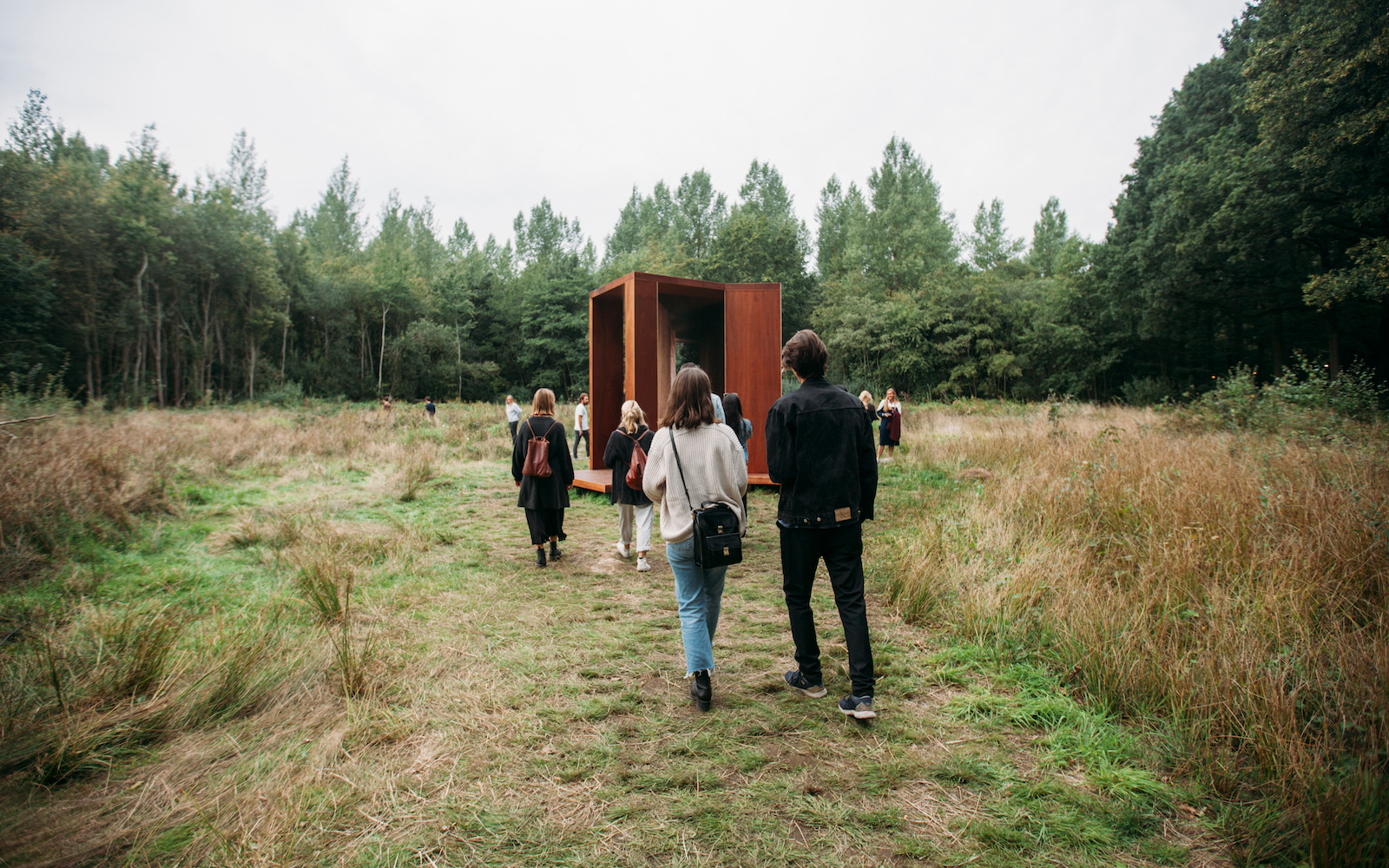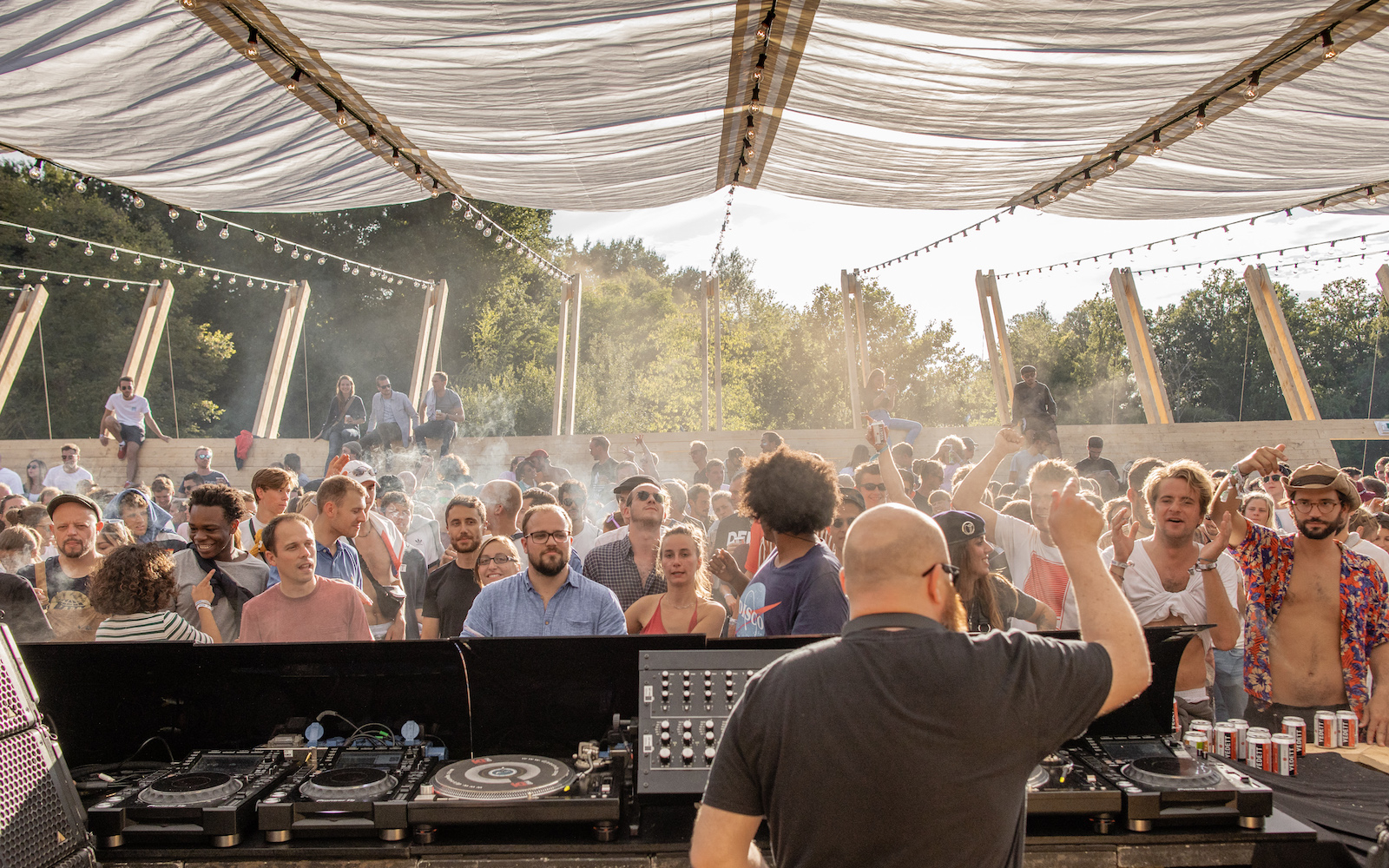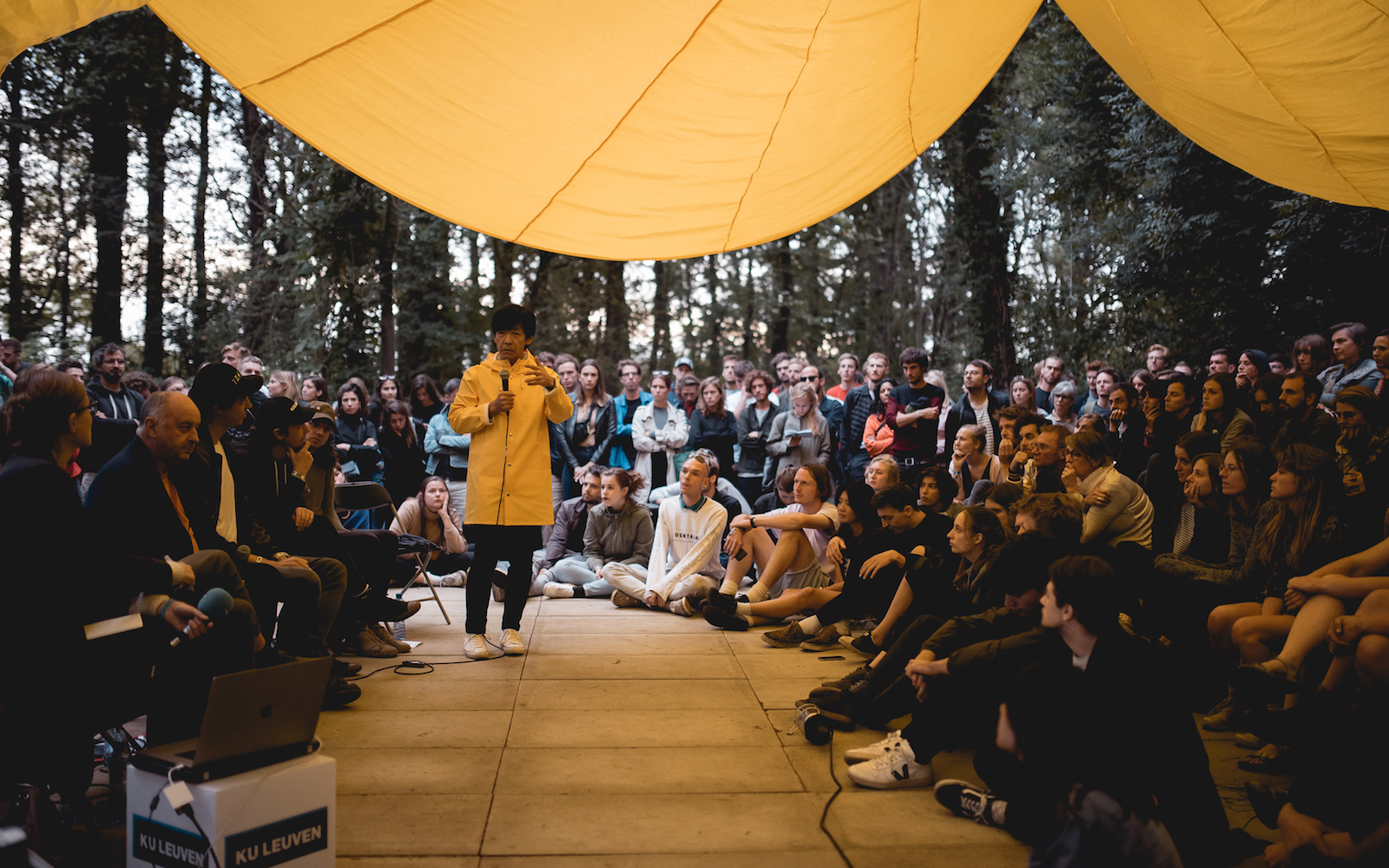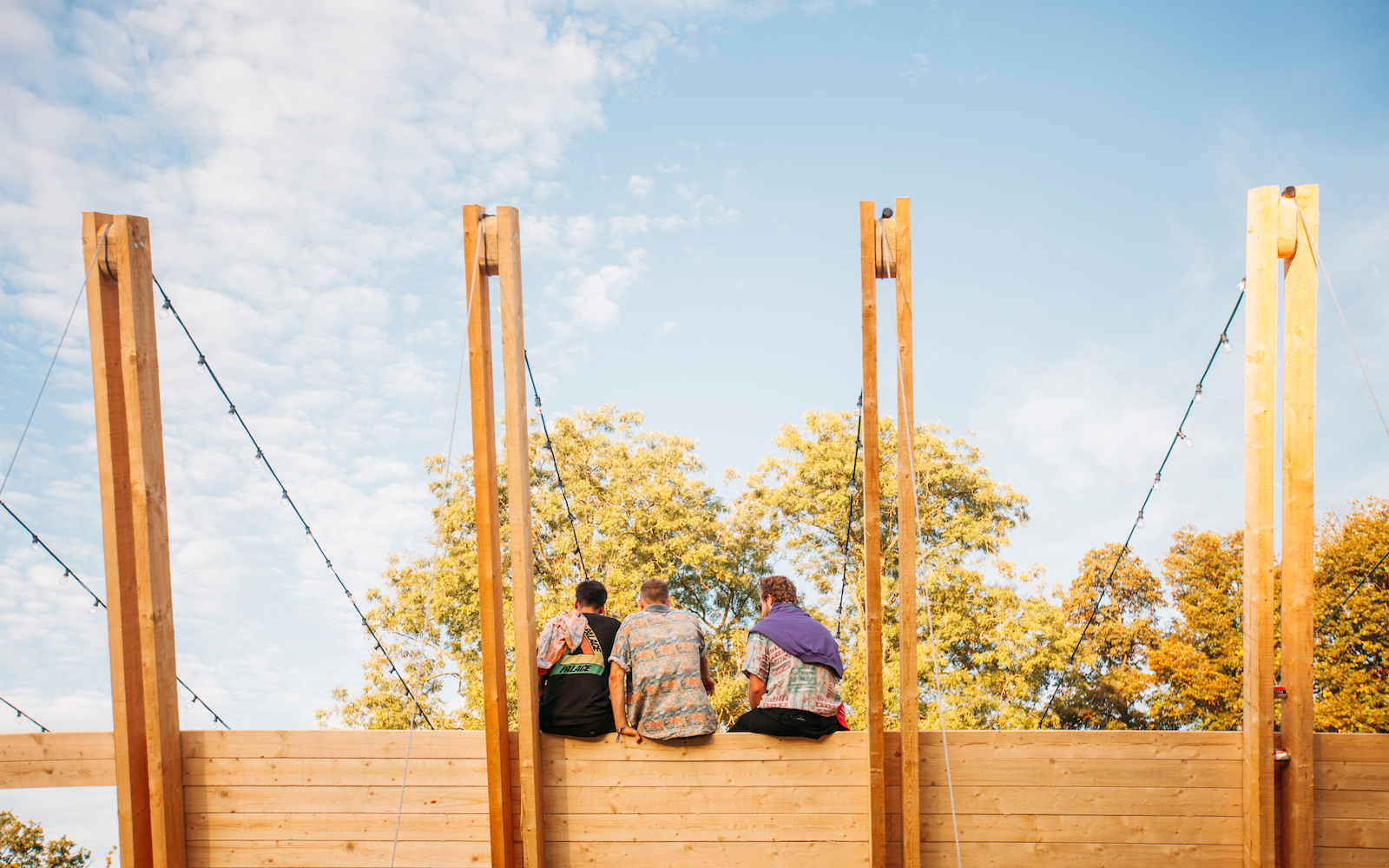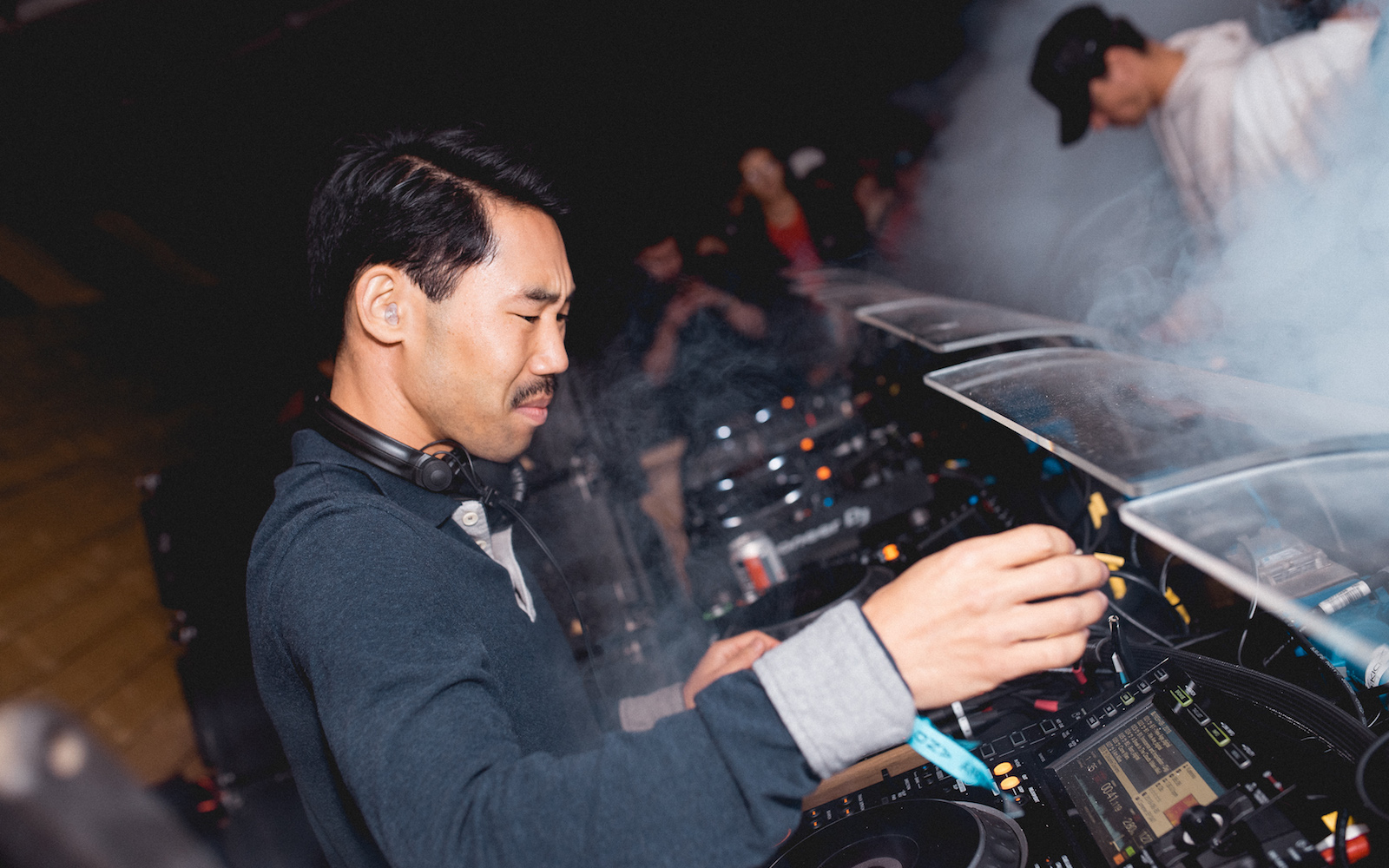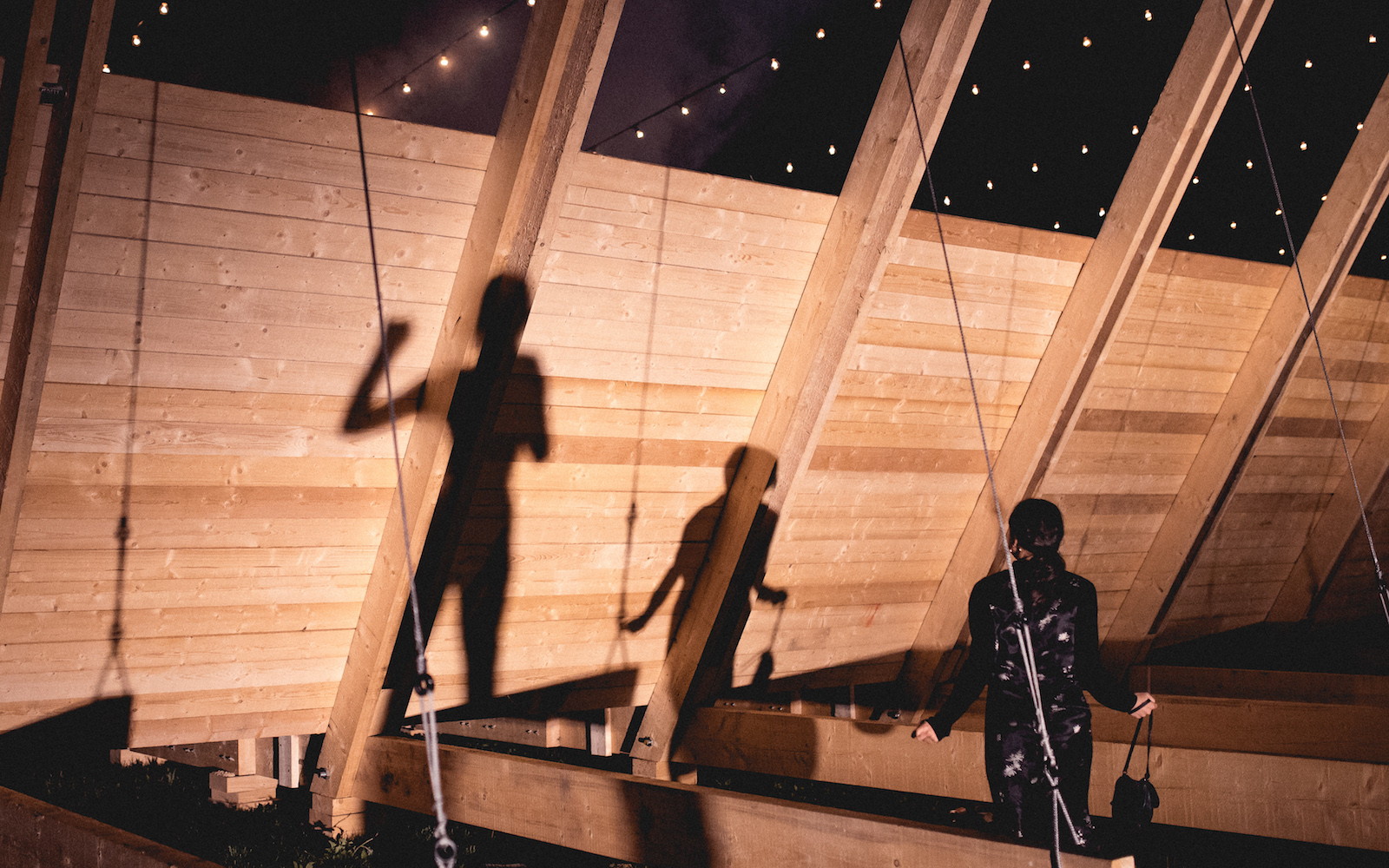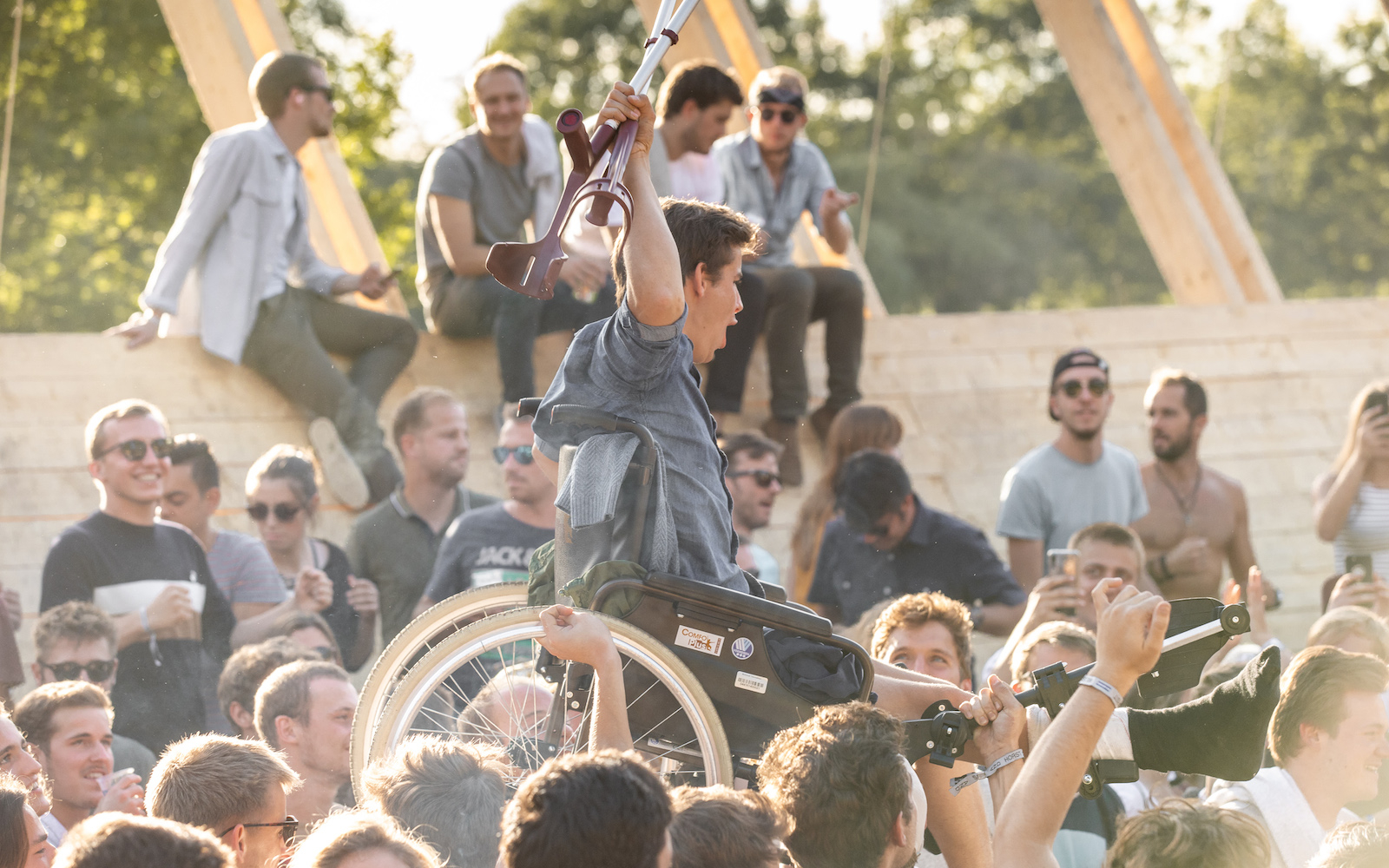Photo credit /
Jeroen Verrecht - Skatebård, Wheelchair
Maxikamera - Talk, Hunee, Shadow, DJ Normal 4
HORST 2018: Five key performances
- PublishedSep 12, 2018
- Words
- Who stole the show at the Belgium festival's last-ever edition? Ray Philp finds out.
- Share
- On Friday afternoon, shortly after arriving at HORST Festival, I was introduced to Willy, a 65-year-old carpenter with a deep tan who lived locally. Alongside more than 20 others, he'd helped construct the stage we were standing on, christened Lakeside Dancers Club, in about 12 days. He pointed to Horst Castle, a centuries-old structure showing signs of wear, and told me of its fictional resident, the Red Knight, or De Rode Ridder, a long-running comic strip in Belgium. The stage, which from a distance looked as though it was anchored in the castle moat, also drew from popular myth. At a lecture the following day, the architect Yoshiharu Tsukamoto explained that Lakeside Dancers Club was inspired by a scene from Gulliver's Travels, in which the hero finds himself bound by ropes on an island inhabited by much smaller people. The dancers, then, were integral to the design—just as the castle and the stage represented "death and life," Lakeside Dancers Club brought together fantasy and reality.
It's unusual to find this sort of conceptual depth at a dance music festival, and HORST's other areas of interest were by turns serious and playful. In the canopied lecture theatre, there were panel talks, presentations and a recital from the festival's "writer in residence." There were several sculptures, including The Crossing, by Leon Vranken, which invited passersby to cross bridges of increasing difficulty. (One of them broke on Sunday.) As enriching as these aspects were, they'd mean a lot less had the party not been so much fun. The lineup featured a few big names, including Motor City Drum Ensemble and Mr Scruff, but the emphasis was often on intimacy, despite the addition of a third day and a third stage. Maurice Fulton, DJ Sports, Octo Octa and Raphaël Top-Secret helped tip the festival's musical balance towards funk, disco and house. The handful of techno artists complemented the upbeat vibe. DJs such as Optimo and Palms Trax caught the mood as well; the former dropped an edit of The Rolling Stones' "Gimme Shelter," and Palms Trax worked his way through some '80s synth pop to land on Depeche Mode's "Enjoy The Silence." The programme notes aside, there was little to suggest that this would be HORST's last edition. Only the Belgian DJ Lefto made the fact explicit when, during his closing set on Sunday, he got on the mic to remind the dance floor, "This is the last HORST—make it count!"
Here are five key performances from across the weekend.
Oceanic The first hour of Oceanic's set at Final Stage was chilly. The temperature under the arena's red canopy was cold enough that you couldn't tell what was smoke and what was people's breath. The music, in turn, was aloof and mysterious—sleek UK techno tracks without vocals or melodies. Apart from the occasional strobe, the lighting was minimal. Oceanic DJ'd with an easy, fluid style, despite the complexity of some of the tracks he played and the blends he tried to pull off. That was clearest midway through. The set's first vocal track, the wicked dub of LAPS's "Who Me?," was followed by a sudden detour: a rich, full-sounding frenzy of kalimba, sax and hand drums. He then swung right back round to the tough UK vibe he'd been riding with Joe's "Rut." It might've gone terribly wrong for a less skilled DJ, but Oceanic handled the transition nicely. For the time that I stuck around, the music got slightly scrappier. One of my favourite tracks had a dubstep-style snare that smacked satisfyingly on the third beat; the other was a 1995 cut from Electronome's "Een Drumcomputer & Een Synthesizer," whose robotic lead sang in desperate, impulsive spasms.
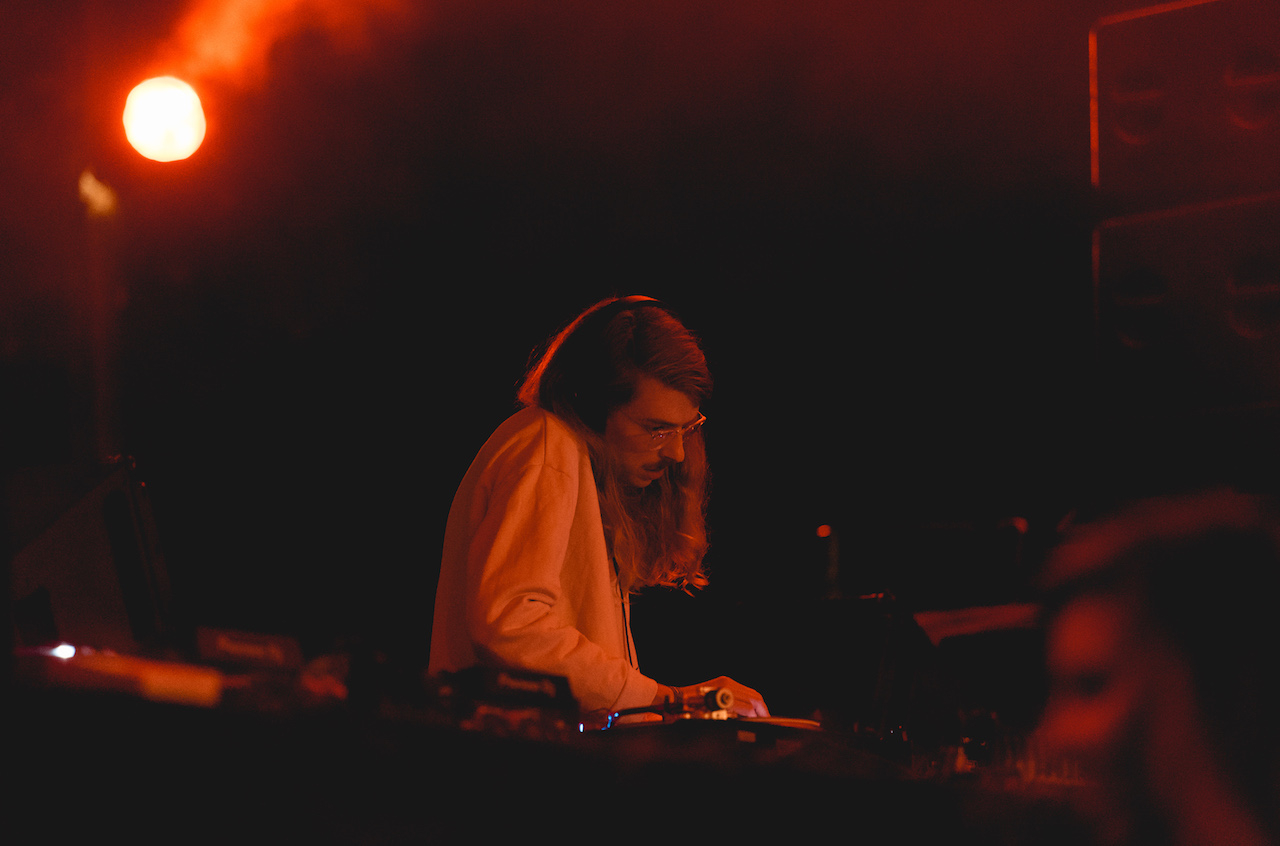 Josey Rebelle On the same stage a few hours later, Josey Rebelle opened with A Guy Called Gerald's "Pacific Samba," some acid techno and a sunny '90s house track. She tended to skew harder thereafter, but the nimble way she mixed these first few tracks was typical of how easily she moved between moods. Her 90 minutes often had a strong British flavour. There were early '90s tracks from Nightmares On Wax ("Aftermath") and Manix ("Feel Good"). She also played an acidy equivalent to Daft Punk's "Teachers," with shoutouts to DJ Storm, Slimzee, LTJ Bukem, Mary Anne Hobbs and countless others. But this was no crash course in UK club music. Just as often, Rebelle used acid techno ragers to build a sense of suspense and pressure, helped by her airtight mixing, that kept the dance floor locked. One of the set's highlights was a high-definition drum track with dub sirens and other rave fragments that I mistook for an unreleased Special Request track (it was actually AQXDM's "Ballad 02," a recent cut on Bedouin Records). Rebelle was no less compelling when the music drifted Stateside. As a modern-sounding remix of "Sharevari" unspooled, I noticed DJ Stingray waiting in the wings, wrapped up in his usual gear against the cold.
Josey Rebelle On the same stage a few hours later, Josey Rebelle opened with A Guy Called Gerald's "Pacific Samba," some acid techno and a sunny '90s house track. She tended to skew harder thereafter, but the nimble way she mixed these first few tracks was typical of how easily she moved between moods. Her 90 minutes often had a strong British flavour. There were early '90s tracks from Nightmares On Wax ("Aftermath") and Manix ("Feel Good"). She also played an acidy equivalent to Daft Punk's "Teachers," with shoutouts to DJ Storm, Slimzee, LTJ Bukem, Mary Anne Hobbs and countless others. But this was no crash course in UK club music. Just as often, Rebelle used acid techno ragers to build a sense of suspense and pressure, helped by her airtight mixing, that kept the dance floor locked. One of the set's highlights was a high-definition drum track with dub sirens and other rave fragments that I mistook for an unreleased Special Request track (it was actually AQXDM's "Ballad 02," a recent cut on Bedouin Records). Rebelle was no less compelling when the music drifted Stateside. As a modern-sounding remix of "Sharevari" unspooled, I noticed DJ Stingray waiting in the wings, wrapped up in his usual gear against the cold.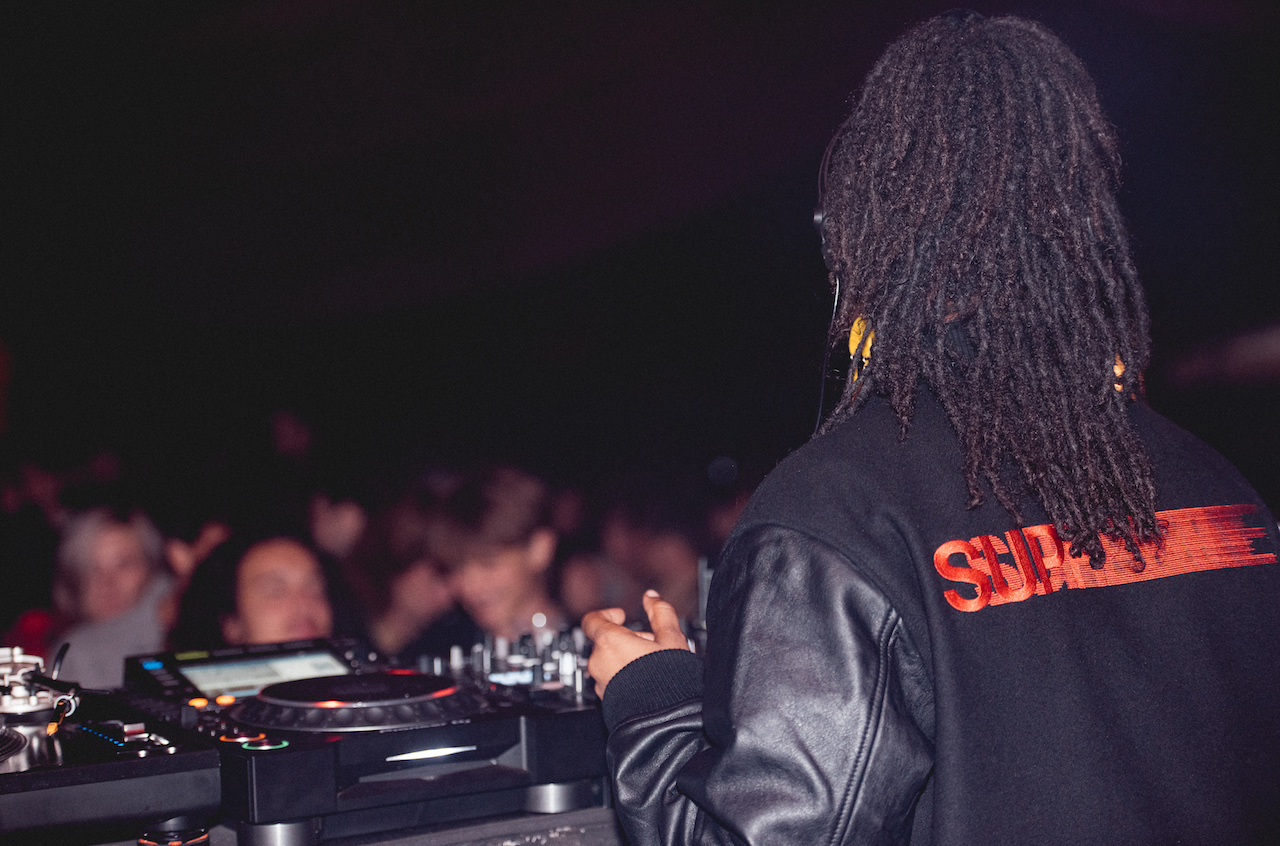 Anastasia Kristensen If you were stationed by the booth at Lakeside Dancers Club, a stage modelled on Noah's Ark and a scene from Gulliver's Travels, it was sometimes only possible to make out the lit ends of roll-ups in the dense artificial fog. Together with the canopy, which extended halfway across the structure, the stage resembled another tall tale: an indoor club with killer air-con where you could smoke to your heart's discontent. This lent the space a heady atmosphere that made it by far the festival's most appealing stage. (It was designed by the Tokyo-based Atelier Bow-Bow, a globally renowned architecture firm.) I dipped in and out of several acts there on Friday and Saturday—Bufiman, DJ Normal 4 and Optimo, all of whom I enjoyed—but stayed to check out Anastasia Kristensen. Though she's essentially a techno DJ, aspects of what she does has roots in other styles. She had this habit of mixing out of tracks with short, sharp backspins. Robert Hood-esque chords mingled with housey counterpoints, including a track near the beginning with a female booty house vocal. The arc of her set made me think of a Rubik's cube: there were lots of little twists—an acid line here, a wild synth line there—but the set's overall shape remained solid, which gave her 90 minutes a nice balance of intensity and variety. She showed that right to the end—her closing track, a colourful Peter Gabriel edit, was a fittingly upbeat goodbye.
Anastasia Kristensen If you were stationed by the booth at Lakeside Dancers Club, a stage modelled on Noah's Ark and a scene from Gulliver's Travels, it was sometimes only possible to make out the lit ends of roll-ups in the dense artificial fog. Together with the canopy, which extended halfway across the structure, the stage resembled another tall tale: an indoor club with killer air-con where you could smoke to your heart's discontent. This lent the space a heady atmosphere that made it by far the festival's most appealing stage. (It was designed by the Tokyo-based Atelier Bow-Bow, a globally renowned architecture firm.) I dipped in and out of several acts there on Friday and Saturday—Bufiman, DJ Normal 4 and Optimo, all of whom I enjoyed—but stayed to check out Anastasia Kristensen. Though she's essentially a techno DJ, aspects of what she does has roots in other styles. She had this habit of mixing out of tracks with short, sharp backspins. Robert Hood-esque chords mingled with housey counterpoints, including a track near the beginning with a female booty house vocal. The arc of her set made me think of a Rubik's cube: there were lots of little twists—an acid line here, a wild synth line there—but the set's overall shape remained solid, which gave her 90 minutes a nice balance of intensity and variety. She showed that right to the end—her closing track, a colourful Peter Gabriel edit, was a fittingly upbeat goodbye.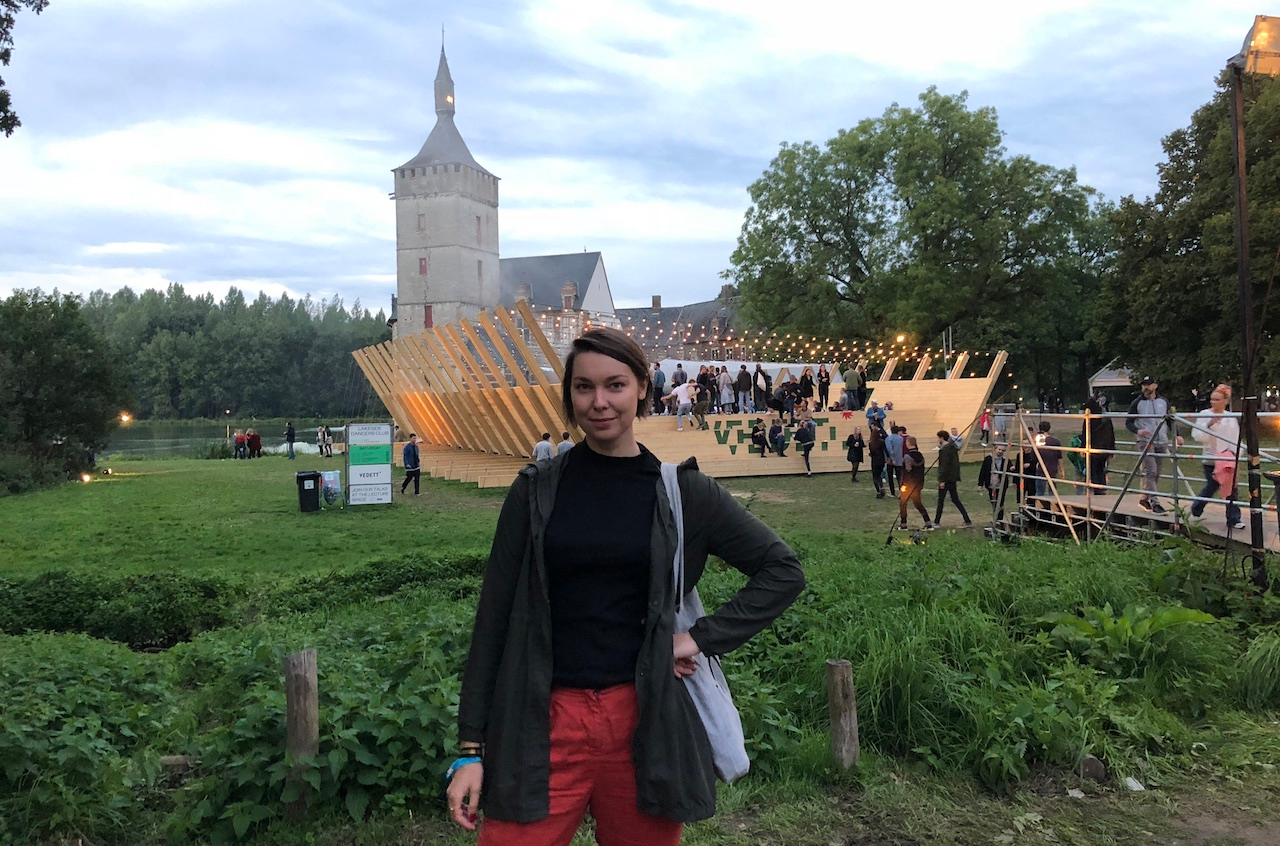 Avalon Emerson Avalon Emerson, like Kristensen, DJs with an intensity rooted in techno. But, as she followed the Danish DJ at Lakeside Dancers Club, her set's vivid hues made it clear that she draws from a far wider pool of records. Amid Emerson's expressive selections, I could make out trumpet riffs, Spanish guitar and rap and R&B vocals. The way she stitched these tracks together was equally impressive. Digital Domain's "I Need Relief" was mixed with an acid track that she cut in with frantic jabs of the fader, adding a kind of triplet rhythm. The melody from Art Of Noise's "Moments In Love" wafted over a charging breakbeat, which was chewed up a little later by the scrapyard-metal crush effect you'd find on a Syclops track. The tracks were as densely packed as the stage itself, which by 11 PM was filled to the gunnels with people. To my left, the stage's architect, Yoshiharu Tsukamoto, wearing an immaculate canary-yellow raincoat, was filming Emerson with his smartphone. Seconds earlier, she'd dropped a house track with a sardonic, fed-up vocal: "Life's a bitch!" In that moment, he may have disagreed.
Avalon Emerson Avalon Emerson, like Kristensen, DJs with an intensity rooted in techno. But, as she followed the Danish DJ at Lakeside Dancers Club, her set's vivid hues made it clear that she draws from a far wider pool of records. Amid Emerson's expressive selections, I could make out trumpet riffs, Spanish guitar and rap and R&B vocals. The way she stitched these tracks together was equally impressive. Digital Domain's "I Need Relief" was mixed with an acid track that she cut in with frantic jabs of the fader, adding a kind of triplet rhythm. The melody from Art Of Noise's "Moments In Love" wafted over a charging breakbeat, which was chewed up a little later by the scrapyard-metal crush effect you'd find on a Syclops track. The tracks were as densely packed as the stage itself, which by 11 PM was filled to the gunnels with people. To my left, the stage's architect, Yoshiharu Tsukamoto, wearing an immaculate canary-yellow raincoat, was filming Emerson with his smartphone. Seconds earlier, she'd dropped a house track with a sardonic, fed-up vocal: "Life's a bitch!" In that moment, he may have disagreed.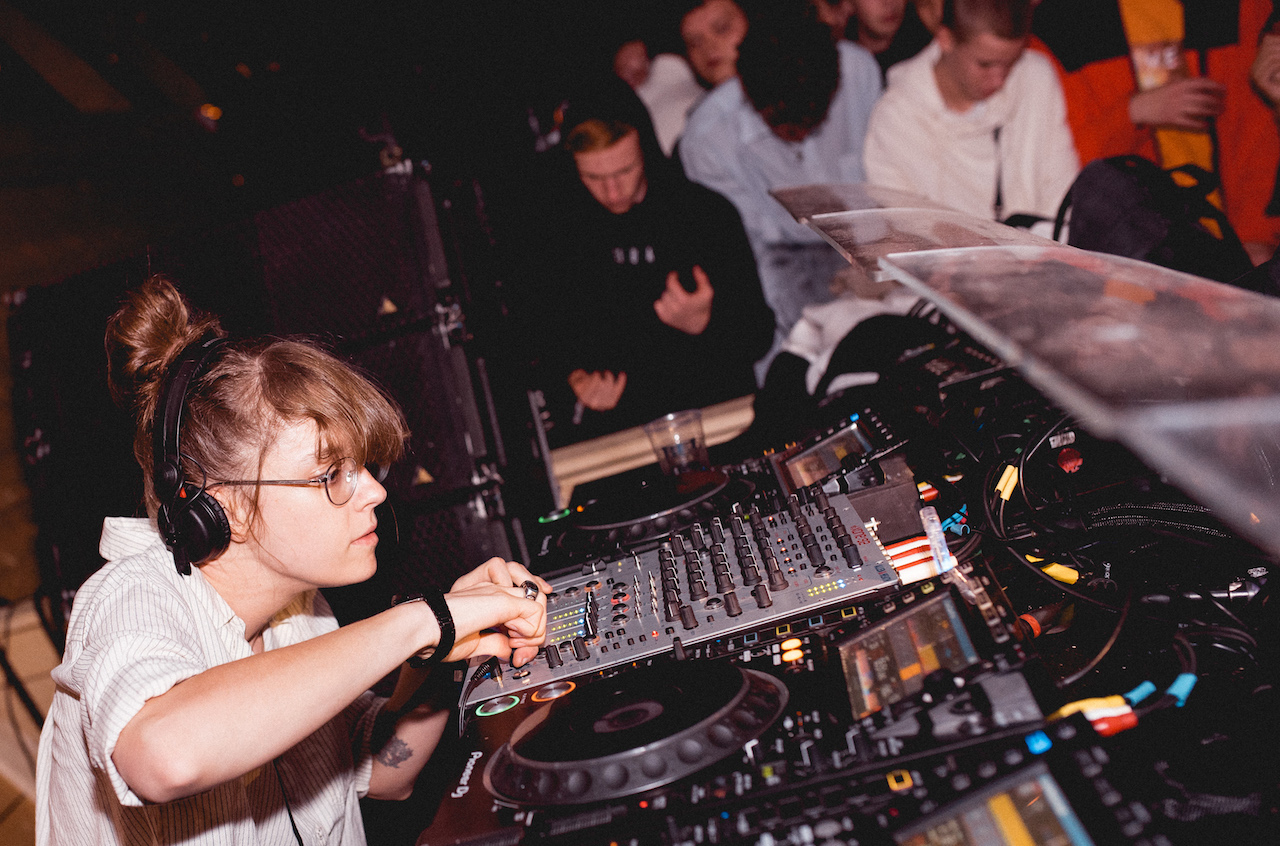 Lefto On Sunday night, Lefto closed Forest Floor, an L-shaped stage in the woods connected by two long gangways to the festival's main area. (It was billed as a "sort-of-secret" stage, but it was easy enough to find.) While the programming at Final Stage and Lakeside Dancers Club was open-ended, Forest Floor's DJs often went for an intimate house party feel. This was true of sets by DJ Python and DJ Fett Burger, the latter of whom unloaded feel-good anthem after feel-good anthem during his last hour, including Underground Resistance's "Timeline" and Chic's "Everybody Dance." Lefto, who has played every edition of HORST, showed similarly crowd-pleasing tendencies across his three-hour slot. "I don't know where to start, guys," he said, ad-libbing on the mic. "Jazz, hip-hop, house. Let's see!" There were thumping tunes from Kerri Chandler and Mall Grab, big disco cuts (Gwen McRae's "Keep The Fire Burning," Chicago's "Street Player"), hip-hop tracks, including from the late Mac Miller, and Wiley's "Wot Do U Call It?" I didn't love everything Lefto played—and the high-impact, party-starting approach isn't generally my thing—but the crowd was into it, and I left admiring the set for its sheer entertainment value. Shortly before he finished, sometime after midnight, I sat in one of the backstage areas to hitch a ride back to Leuven. For a moment, the loudest noise wasn't the music from the nearby stages, but a chant farther away: "Lefto! Lefto! Lefto!"
Lefto On Sunday night, Lefto closed Forest Floor, an L-shaped stage in the woods connected by two long gangways to the festival's main area. (It was billed as a "sort-of-secret" stage, but it was easy enough to find.) While the programming at Final Stage and Lakeside Dancers Club was open-ended, Forest Floor's DJs often went for an intimate house party feel. This was true of sets by DJ Python and DJ Fett Burger, the latter of whom unloaded feel-good anthem after feel-good anthem during his last hour, including Underground Resistance's "Timeline" and Chic's "Everybody Dance." Lefto, who has played every edition of HORST, showed similarly crowd-pleasing tendencies across his three-hour slot. "I don't know where to start, guys," he said, ad-libbing on the mic. "Jazz, hip-hop, house. Let's see!" There were thumping tunes from Kerri Chandler and Mall Grab, big disco cuts (Gwen McRae's "Keep The Fire Burning," Chicago's "Street Player"), hip-hop tracks, including from the late Mac Miller, and Wiley's "Wot Do U Call It?" I didn't love everything Lefto played—and the high-impact, party-starting approach isn't generally my thing—but the crowd was into it, and I left admiring the set for its sheer entertainment value. Shortly before he finished, sometime after midnight, I sat in one of the backstage areas to hitch a ride back to Leuven. For a moment, the loudest noise wasn't the music from the nearby stages, but a chant farther away: "Lefto! Lefto! Lefto!"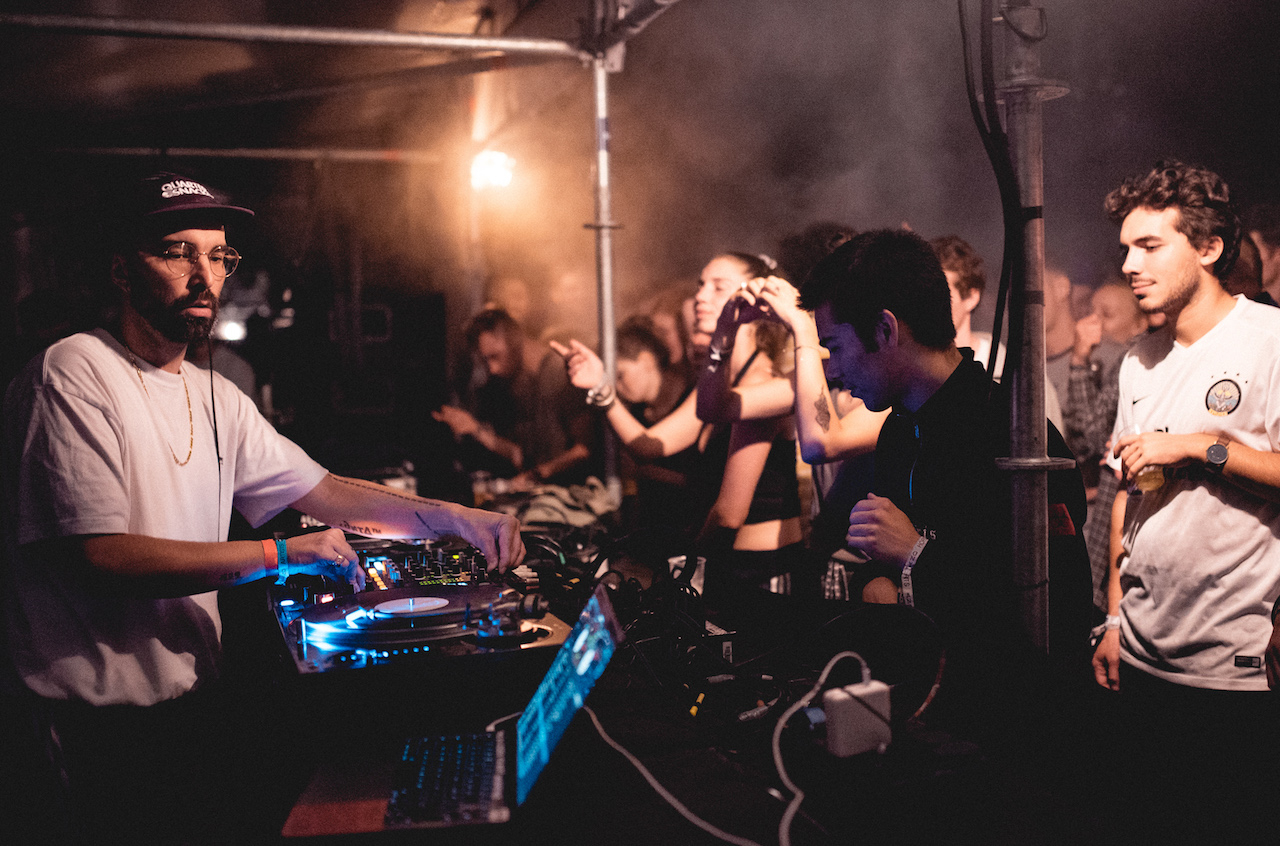 0303
0303